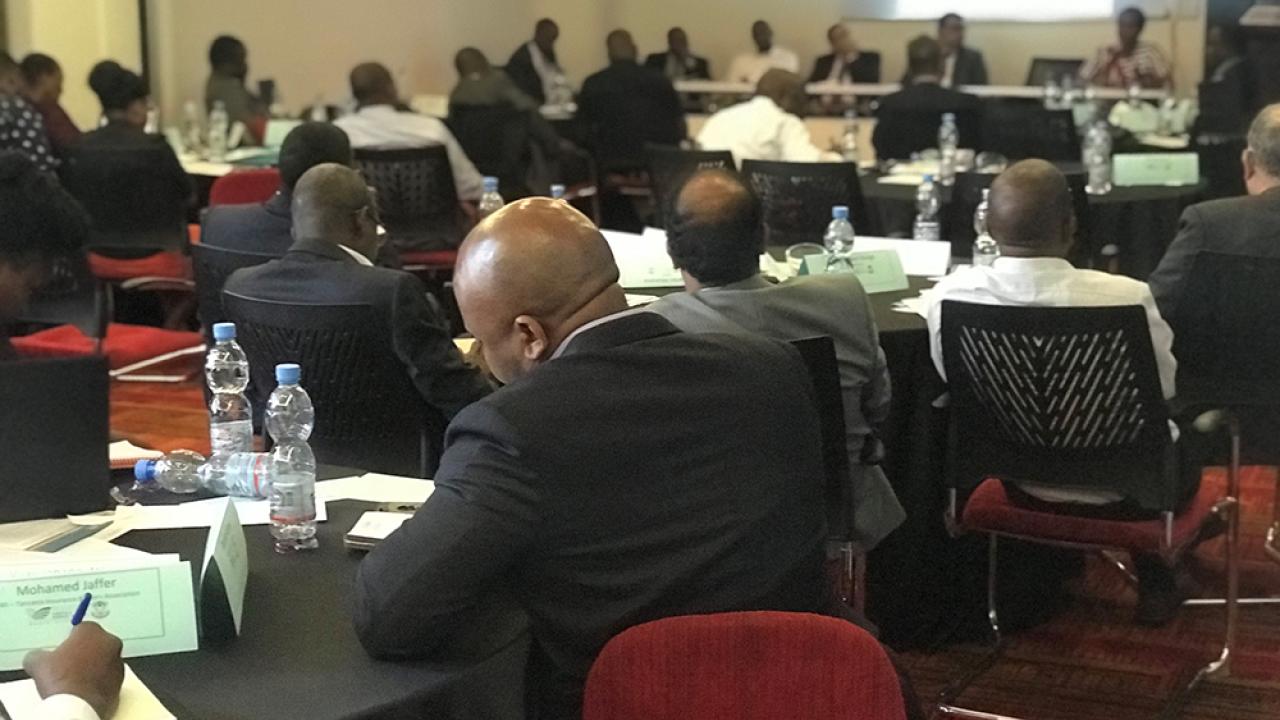
Leaders on Agricultural Index Insurance in Africa Convene to Share Lessons on Public-private Partnerships
Increasingly frequent drought in Sub-Saharan Africa and recent successes with agricultural index insurance to protect farmers and pastoralists has sparked interest across the continent to launch and scale quality interventions.
The Feed the Future AMA Innovation Lab convened insurance leaders from research, government and the private sector to exchange knowledge on effective agricultural index insurance for economic development. The closed-session event, “Agricultural Insurance in Tanzania: Public and Private Sector Roles and Responsibilities,” took place on July 19, 2018 in Dar Es Salaam, Tanzania and was organized at the invitation of the Tanzania Insurance Regulatory Authority (TIRA).
“With about 80 percent of the Tanzania population depending on agricultural activities for their livelihood this kind of conference is paramount,” wrote TIRA commissioner Baghayo Saqware in opening remarks read by TIRA director of market development Adelaida Muganyizi.
Sharing Lessons to Empower Future Leaders
The event was a unique opportunity for insurance leaders from government, donors and the private sector across Africa to spark new or more effective agricultural index insurance interventions. Agricultural index insurance could be a critical tool for promoting resilience in Sub-Saharan Africa, where a constant threat of drought makes and keeps agricultural households poor.
Private sector leaders included Mwombeki Baregu from Financial Sector Deepening Trust, who presented on crop insurance in Tanzania. Hassan Bashir, CEO of Takaful Insurance, presented on his company’s implementation of index insurance in Kenya. Bashir pioneered Index-based Livestock Insurance in Kenya and Ethiopia in a public-private partnership with the International Livestock Research Institute (ILRI) and with support from the AMA Innovation Lab.
“If you target the biggest risk, which is drought, then perhaps you can improve the livelihoods of pastoralists or save their assets,” said Bashir. “This is a risk that needs to be managed though a shared risk approach—public-private partnership.”
Presentations and discussions also included representatives from national efforts on agricultural index insurance. Charles Mukama from the Uganda Ministry of Agriculture, Animal Industry and Fisheries presented on agricultural insurance in Uganda. From the Kenya Ministry of Agriculture, Tom Dienya presented on Kenya’s National Agricultural Insurance Program and Richard Kyuma discussed the Kenya Livestock Insurance Program (KLIP).
“The national and county governments have the responsibility to create an enabling environment,” said Kyuma. “We are currently playing the role of lead for resource mobilization, capacity building, and private sector mobilization – helping to develop the appropriate infrastructure for this kind of product to thrive."
Ali Muhammad Katu, general manager at the Ghana Agricultural Insurance Programme (GAIP) discussed some of the implementation challenges he has observed in Ghana.
“Working with partners is essential,” said Katu. They can help teach us to crawl, walk and run, but once the partnerships end we need to make sure we are not still only crawling. We need to teach ourselves how to walk and run.”
Researchers presented on some of the most recent findings on index insurance for development. Duncan Khalai, a market and capacity development specialist at ILRI, summarized key lessons from implementing livestock insurance in Kenya and Ethiopia. Economist Paswel Marenya described CIMMYT’s experience of pairing drought-tolerant maize with index insurance in Tanzania.
Implementing Index Insurance with Quality First
The AMA Innovation Lab’s contribution focused discussion on two ideas. The first was evidence on the potential positive impacts of agricultural index insurance. These include recent findings on promoting greater investments in productivity as well as earlier findings on how index insurance helps households to maintain consumption despite drought.
The second main idea, and one that is equally important, is how to improve the quality of index insurance products worldwide. Index insurance quality is a serious barrier to achieving the technology’s potential for economic development, which can only be reached with high-quality contracts that genuinely protect households.
“People were really interested in the discussions we had about index insurance quality,” said Carter. “For many, this is a first step in helping to establish international quality standards for agricultural index insurance.”
The AMA Innovation Lab has used standard economic and statistical tools to develop an objective measure of index insurance quality that can be used to establish a broadly adopted Minimum Quality Standard (MQS) for index insurance. Ensuring that all agricultural index insurance contracts meet MQS will protect households from contracts that could leave them worse off than having no insurance at all.
Carter said that in Tanzania the quality of index insurance contracts—mainly in how effectively they pay out when an insured farmer a loss—and the cost of those contracts will determine the success of growing markets for agricultural index insurance.
“The challenge is to design fail-safe index insurance contracts and to find the right mix of prudential regulation and public-private partnership to reap the dividends possible from reducing risk,” said Carter.
All presentations and an agenda of the proceedings are available online. The event was an activity of the AMA Innovation Lab’s Index Insurance Innovation Initiative (I4), an AMA Innovation Lab index insurance research and outreach initiative supported by USAID.
Learn more about the event and download presentation slides.
Media contact:
Alex Russell, (530) 752-4798, parussell@ucdavis.edu
